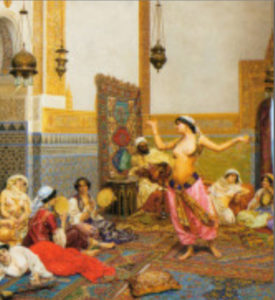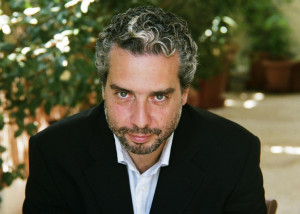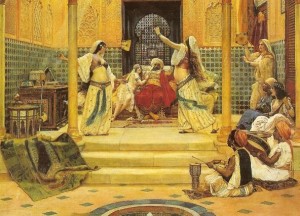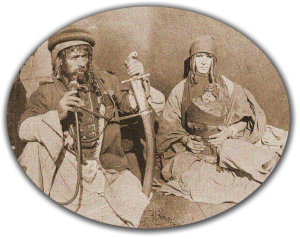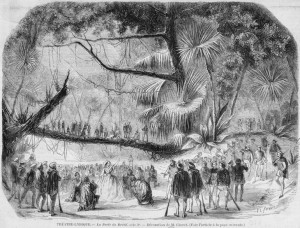Die verdienstvolle musik-archäologische Arbeit des Palazetto Bru Zane geht weiter, und wir wie auch Félicien David profitieren davon. Bei der Firma Aparté (AP086) singt der renommierte griechische Bass-Bariton Tassis Christoyannis eine Sammlung an französischen Liedern von David, begleitet von Thanassis Apostolopoulos am Klavier. Seine (für mich) erotische, dunkle und außerordentlich ausdrucksvolle Stimme durchmisst im Mitschnitt aus dem Megaron Athen im Juli 2013 diese orientalisch inspirierten kleinen Genrestücke mit großmöglichstem Effekt. David schuf sie nach seinen Ausflügen in die arabische Welt (Ägypten und Algerien) – Länder, die er 1832 – 1835 auf seiner „Missions“-Reise im Dienste der Saint-Simonianischen Lehre erlebte. Nach Paris zurückgekehrt, schrieb er unter dem Eindruck des Lichtes und der Farben, des Lebens in Nordafrika diese Lieder. Aus dieser Atmosphäre stammt auch seine Tondichtung Le Désert (1844), die im Mai (2014) unter Laurence Equilbey in Paris konzertant gegeben wurde und die ebenfalls in diesem Jahr (2014) auf CD herauskommen und die ältere Capriccio-Aufnahme ersetzen wird. Nachstehend ein Aufsatz von Etienne Jardin zu diesen Kompositionen aus dem Booklet der CD-Ausgabe bei Aparté in Zusammenarbeit mit dem Palazetto Bru Zane – un très grand mercii! G. H.
‚Here are three more songs by M. Felicien David, the composer of the odes-symphonies who, despite his attempts and successes in the grand genre has all the requirements, by the very nature of his talent, to produce these small sparks of music that scintillate in our salons.‘ (Revue et Gazette musicale de Paris, 12 September 1847)
To the East: Orphaned at the age of five, Felicien David (1810-1876) trained at the choir school of St Sauveur Cathedral in Aix- en-Provence, before entering the Paris Conservatoire in 1830. There, he attended the classes of Millault (harmony), Fetis (counterpoint) and Benoist (organ), while also studying privately with Reber. Not for long, however. After meeting the painter Pol Justus in 1831, he left the Conservatoire without obtaining any prizes to join the Saint-Simonian movement and became its official composer. When the community led by Pere Enfantin (1796-1864) was disbanded by government order the following year, David left France with a group of friends to spread the Saint-Simonian gospel in the East, a journey that took him to countries including Egypt and Algeria. In June 1835 he returned to Marseille with the firm intention of expressing his fascination for the East through his music and making a name for himself in Paris as a composer.
Back in France: David’s first published work (1836) was his collection of Melodies orientales for piano, which enjoyed little immediate success and, to make matters worse, all the unsold copies were destroyed in a fire a few months later. The friendly community network he had known in Paris at the beginning of the July Monarchy had largely disappeared: many of his fellows had distanced themselves from the Saint-Simonian movement and there was little potential support for the young musician. One of them, however, Felix Tourneux, did stand by him: he gave him hospitality and for several years (1837-41) David lived in his friend’s summer home in Igny, devoting his time to study, composition and gardening. He kept in touch with Felix Tourneux after that and set texts written by his wife, Emma Tourneux (Adieuxa Charence, 1842, Reveries, 1844). In 1841 David returned to Paris (where he stayed with his brother), determined to conquer the music world.
Conquering the capital: By the 1840s Paris was the musical hub of Europe, a city in constant effervescence that attracted the great virtuosos of the time, a city where instrument making and music publishing flourished. There was a rapid increase in the number of public concerts presented in the capital and these took on a multiplicity of forms, with symphony concerts at the Societé des Concerts du Conservatoire, the popular concerts of Valentino and Musard, the many chamber concert series of those following in the wake of Pierre Baillot, song recitals, and so on. Before tackling opera, which for a French composer was the ultimate test, David chose to turn to these new areas of music, prompted by the aesthetics that he intended to promote and by his acquaintances in the musical milieu. In 1838 his Symphony in F major was performed at the Concerts Valentino; in 1839 the Concerts Musard premiered a Nonetto for brass; in 1842, for the series of chamber concerts presented by his friend, the violinist Jules Armingaud, he wrote a set of twenty-four string quintet movements, Les Quatre Saisons; then in December 1844 he attained the heights of fame when his Ode-symphonie Le Desert was staged at the Theatre-ltalien. (The work was subsequently revived by the Societe des Concerts in 1847.)
Romances – a flourishing trade: Félicien David’s art songs for voice and piano, most of which were published between his return from Egypt (1835) and the end of the July Monarchy (1848), are in line with the strategies of a young composer whose twofold aim was to earn his living as a composer and make a name for himself in the capital. From the 1820s, the romance, which had experienced its first heyday in the salons of the First Empire, was gaining in popularity. While wealthy urban families acquired a piano and learning to play the instrument became part of the standard education of the new elite, there was correspondingly a sharp increase in the demand for simple pieces for voice and keyboard, and publishers did a flourishing trade in such scores. Motivated by the resources that such pieces had to offer, the young Wagner composed eight romances during his stay in Paris in 1839-40. At the time of the July Monarchy, romances, intended primarily for private performance (in the salons), began to feature in response to popular demand on the programmes of public concerts; they were also chronicled in the music press and sometimes even published as supplements to periodicals. A year before the premiere of his first Ode- symphonie, Le Desert, David was described as ‚the king of the salons‘ (Le Monde musical). By taking these lighter works into the homes of the aristocracy and the middle classes, he prepared for the triumphant success of his more ambitious compositions. Before the end of the July Monarchy, Le Desert was being performed in cities all over France, from Boulogne-sur-Mer to Marseille.
From the romance to the mélodie: Paving the way for his large-scale vocal works – the oratorio Moise au Sinai (1846-47), then the operas La Perle du Bresil (1851), Herculanum (1859), Lalla-Roukh (1862), La Captive (finished in 1864, but not performed during the composer’s lifetime), Le Saphir (1865) – David’s art songs belong to a genre that was then undergoing substantial change. They date from the time when, under the influence of the German lied, and with composers such as Niedermeyer, Meyerbeer and Monpou, French vocal compositions were gradually moving away from the early nineteenth-century romance. Felicien David was thus instrumental in that change, which was to be completed by Gounod and Berlioz: as the romance waned, the mélodie came into its own.
Schubert’s lieder had been very popular in Paris since the early 1830s and David became known as ‚le Schubert francais‘ (he was not the only one: Henri Reber and Auguste Vaucorbeil also had that honour). The Viennese composer’s influence can indeed be felt in some of his pieces. Le Nuage, for instance, is reminiscent of Gretchen am Spinnrade, and his piano is often similarly expressive, as in L’Ocean; he likewise makes use of echo effects (Reviens, reviens!) and effective alternations of major and minor modes (Le Vieillard et les roses and Oubli!). Furthermore, Frangois Wartel (1806-1882), who was the first singer to perform David’s melodies in concert, was a great exponent of Schubert’s lieder in France, to the point of being nicknamed ‚Wartel-Schubert‘.
 The exotic element: The titles of some of the pieces – Le Bedouin, for example, published in 1839, with words ‚in imitation of the Arabic‘ by Jacques Cognat, a Saint-Simonian who had also been a member of the Egyptian mission, and Le Tchibouk (1845), to a text by Louis Jourdan – reflect David’s taste for the exotic. And Reviens, reviens!, a setting of Theophile Gautier’s poem Absence, is one of the six pieces that make up the song cycle Les Perles d’Orient, published in the mid-1840s. The exotic elements are not really conveyed by the music itself, however; David creates local colour by his rhythmic treatment of these melodies: the harshness of the piano in Le Bedouin, evoking the drum and plucked strings; the bolero accompanying Le Tchibouk gives it a rhythmic vigour that is further amplified by the Arabic words in the text.
The exotic element: The titles of some of the pieces – Le Bedouin, for example, published in 1839, with words ‚in imitation of the Arabic‘ by Jacques Cognat, a Saint-Simonian who had also been a member of the Egyptian mission, and Le Tchibouk (1845), to a text by Louis Jourdan – reflect David’s taste for the exotic. And Reviens, reviens!, a setting of Theophile Gautier’s poem Absence, is one of the six pieces that make up the song cycle Les Perles d’Orient, published in the mid-1840s. The exotic elements are not really conveyed by the music itself, however; David creates local colour by his rhythmic treatment of these melodies: the harshness of the piano in Le Bedouin, evoking the drum and plucked strings; the bolero accompanying Le Tchibouk gives it a rhythmic vigour that is further amplified by the Arabic words in the text.
The Dutch musicologist Frits Noske, in his study of Le Desert, thus suggests that the composer ‚evokes, rather than depicts‘ these Eastern atmospheres. Like Berlioz dreaming of England, Félicien David speaks of North Africa and the Middle East using a French musical language of Viennese inspiration. Indeed, we find not only harmonic patterns characteristic of Schubert, but also, at the same time, the melodic sweetness that, according to researcher David Turney, has been a typical feature of French music since the seventeenth-century air de cour. All of Félicien David’s art songs show an innocence that Berlioz and Saint-Saens saw as their finest quality, as well as a simplicity that favoured their success by making them accessible to all.
Etienne Jardin
Palazzetto Bru Zane / Centre de musique romantique francaise
Bild oben: Rosati/Im Harem, um 1870

